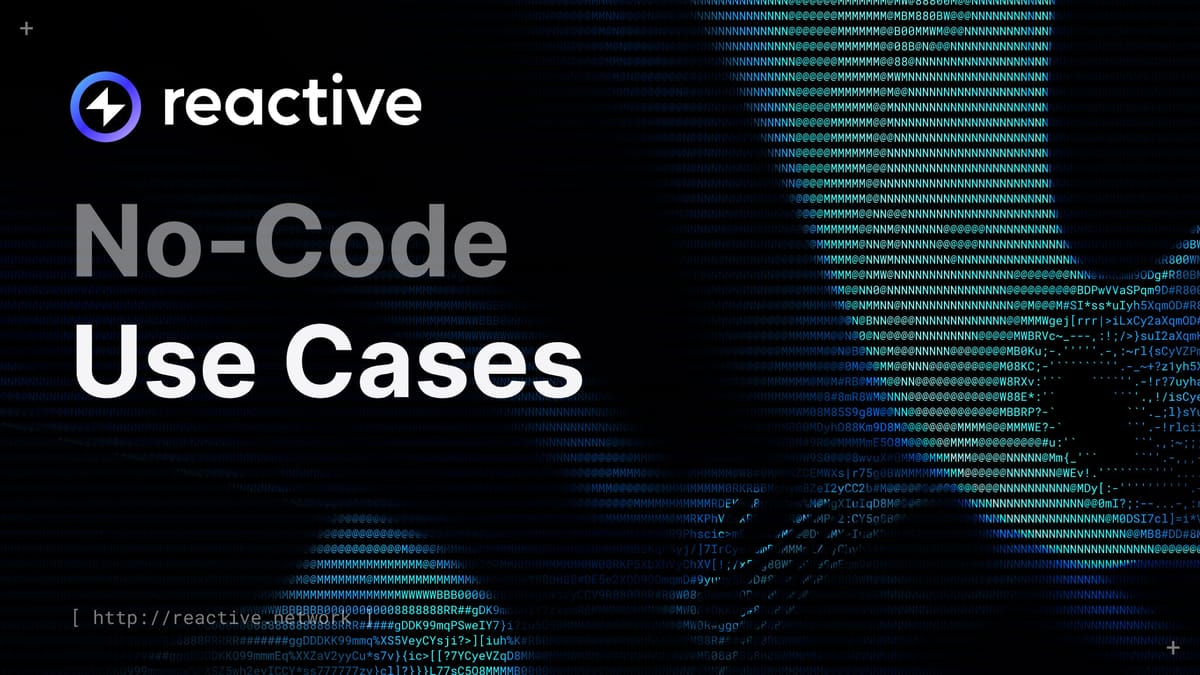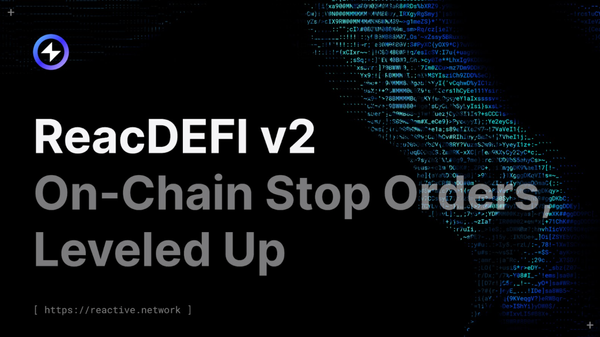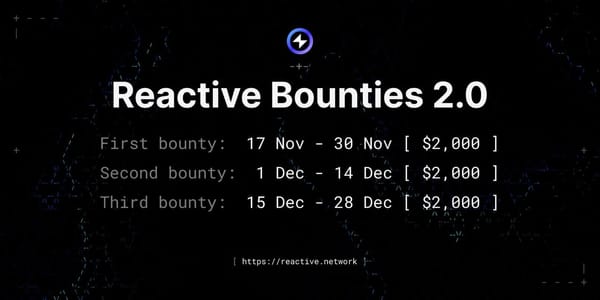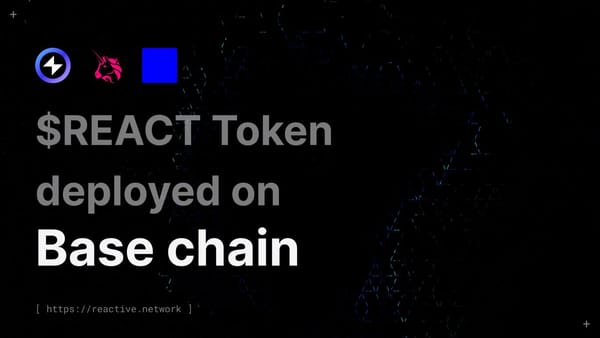No-Code Use Cases
The Reactive Hackathon highlighted groundbreaking no-code solutions like Crypto AutoPay, Content Verification Platform, and Token Turnover Tracker, showcasing how Reactive Smart Contracts automate and optimize blockchain workflows.

Introduction
The recent Reactive Hackathon featured three remarkable no-code solutions — Crypto AutoPay, Content Verification Platform, and Token Turnover Tracker. Each adapts reactive contracts to optimize operations, automate complex workflows, and ensure reliability without sacrificing transparency or security. These event-driven platforms react instantly to on-chain signals, orchestrating a wide range of processes from automated recurring payments to dynamic content verification and real-time token analytics. Together, they reflect a new era of flexibility, affordability, and user autonomy in the realm of DeFi and blockchain applications.
Crypto AutoPay: Recurring Payments with Reactive Contracts
Overview
In a landscape where managing recurring cryptocurrency transactions can feel like juggling flaming torches, Crypto AutoPay replaces chaos and uncertainty with precision and ease. The first-place no-code solution simplifies how users handle regular outflows — whether subscriptions, charitable donations, or business billing — through an automated, affordable, and user-centric framework.
How It Works
The process begins with an on-chain authorization event, in which the user designates a specified token amount for recurring disbursements. A reactive contract continually monitors the blockchain for events that match predetermined criteria — such as frequency, amount, or beneficiary address — and triggers the corresponding transfer the instant these conditions are met. Instead of manually overseeing each payment cycle, users can rely on this self-sustaining mechanism that executes obligations.
Key Features and Advantages
Effortless Automation: By eliminating repetitive manual steps, Crypto AutoPay transforms time-consuming tasks into “set-it-and-forget-it” financial routines.
Cost-Effective Operation: Leveraging lightweight reactive scripting over conventional automation services significantly reduces overhead costs.
User-Defined Flexibility: Payment parameters — from frequency to destination — are fully customizable, fitting a spectrum of recurring financial commitments.
Decentralized Control: With no centralized intermediaries, users maintain complete authority over their assets, reinforcing trust and resilience in a rapidly shifting marketplace.
Use Cases and Audience
Crypto AutoPay’s versatility appeals to a diverse demographic. DeFi enthusiasts can ensure regular NFT or liquidity contributions; businesses gain a billing mechanism; and charitable organizations or DAOs can automate periodic donations. For instance, automated payments for digital subscriptions, recurring loan installments, or ongoing investment deposits simplify financial planning while enabling transparent, time-bound commitments.
Technical Considerations and Scalability
Running on Ethereum-based smart contracts and integrated into the Reactive Network, Crypto AutoPay continuously listens for relevant on-chain signals. By using rate-limited transfers, granular access controls, and comprehensive transaction logs, this infrastructure ensures that all payments are both secure and fully auditable.
Content Verification Platform
Overview
Content verification is the lifeblood of any user-generated platform. The second-place no-code solution presents a modular content verification framework built on reactive contracts. The approach separates the listing process from the verification workflow, allowing operators to refine or replace verification logic without disrupting how users list their NFTs.
How It Works
Submissions — such as NFTs — are first recorded on-chain but remain invisible until they pass a sequence of verification checks. A reactive contract orchestrates each stage of evaluation: automated AI scanning, community-driven manual reviews, and — if necessary — final expert assessments. By segregating the “verify” function into a dedicated module, platform operators can evolve their verification policies and tools without ever tinkering with how items are initially listed.
Key Features and Advantages
Modular Structure: Verification logic is decoupled from listing mechanics, allowing upgrades or replacements of AI models and expert reviewers without halting platform operations.
Dynamic Process: Multiple verification layers — from automated checks to human-driven evaluations — ensure that content quality standards remain up-to-date.
Continuous Adaptability: As new challenges emerge or criteria change, platform owners can incorporate fresh verification methodologies with minimal reconfiguration.
Use Cases and Audience
Consider a travel-themed NFT marketplace. Newly submitted NFTs first undergo AI verification to confirm relevance. If the AI flags uncertainties, the submission escalates to a panel of manual reviewers. Persistent disputes trigger a review by a subject matter expert for a definitive ruling. This framework is equally valuable for any platform that needs to validate user-generated content — art marketplaces, scientific data repositories, or educational material libraries — allowing operators to maintain accuracy and consistency without pausing their services.
Technical Considerations and Scalability
Implementation hinges on an event-driven architecture. Each new listing emits signals that the reactive contract captures, routing content through appropriate verification tiers. Integrating a new AI model or human review team involves merely updating the contract’s callback references, enabling endless reconfigurations without overhauling the entire platform. This approach ensures that scaling up — whether by adding specialized experts or advanced automated filters — remains as straightforward as swapping out a single component in a well-oiled machine.
Token Turnover Tracker
Overview
In the frantic pace of DeFi markets, obtaining immediate insights into token transfers is akin to having a telescope trained on a comet’s trajectory — every second matters. The Token Turnover Tracker is the third-place no-code solution that provides instantaneous, data-driven observations of ERC-20 token activities. By continuously processing transactions as they occur, it delivers valuable intelligence to investors, developers, and analysts who must respond fast to emerging trends and potential red flags.
How It Works
The Tracker monitors the blockchain for ERC-20 token transfer events, funnels these signals through a reactive workflow, and organizes the data into intuitive dashboards and charts. This pipeline spares users the grunt work of manual data gathering and processing. Instead, they gain immediate access to transaction frequencies, unusual movements, and historical comparisons — all essentials for informed decision-making.
Key Features and Advantages
Immediate Transparency: Real-time analytics offer minute-by-minute snapshots of token flows, revealing surges, slowdowns, or suspicious activity at a glance.
Comprehensive Visualization: Consolidating multiple tokens into a single interface makes it easy to spot patterns, cross-compare trends, and identify potential opportunities or risks.
Reduced Manual Labor: Automated data capture and analysis free users from sifting through raw blockchain data, granting them more time to interpret and act on insights.
Use Cases and Audience
For investors, the Token Turnover Tracker signals market sentiment shifts in near real-time, enabling timely reactions to price volatility or liquidity changes. Developers can monitor their own token distributions to detect irregularities and measure adoption. Analysts and researchers benefit from aggregated views of token activity across multiple projects, supporting investigative work and long-term strategic planning.
Technical Considerations and Scalability
Built on reactive programming principles, the Tracker integrates with tools like Web3.js and flexible database solutions such as Airtable or Google Sheets. Through simple webhooks, it relays updates in real-time, allowing for rapid scaling and effortless incorporation of new metrics, verification tiers, or analytical models. As DeFi evolves, the Tracker can adapt, ensuring that its users remain equipped with cutting-edge intelligence tools.
Conclusion
The three no-code solutions that emerged from the Reactive Hackathon — Crypto AutoPay, Content Verification Platform, and Token Turnover Tracker — demonstrate how reactive contracts can optimize complex blockchain processes. By reacting to events the instant they occur, these solutions transform once-manual, error-prone, or static workflows into adaptive, cost-effective, and transparent systems. They enable users to customize their financial commitments, refine verification standards, and monitor token activity in real-time. In an ecosystem that often demands both agility and trust, these solutions act as catalysts, enabling a new generation of blockchain-driven experiences that are as dynamic and responsive as the signals they follow.
About Reactive Network
The Reactive Network, pioneered by PARSIQ, ushers in a new wave of blockchain innovation through its Reactive Smart Contracts (RSCs). These advanced contracts can autonomously execute based on specific on-chain events, eliminating the need for off-chain computation and heralding a seamless cross-chain ecosystem vital for Web3’s growth.
Central to this breakthrough is the Inversion of Control (IoC) framework, which redefines smart contracts and decentralized applications (DApps) by imbuing them with unparalleled autonomy, efficiency, and interactivity. By marrying RSCs with IoC, Reactive Network is setting the stage for a transformative blockchain era, characterized by enhanced interoperability and the robust, user-friendly foundation Web3 demands.





